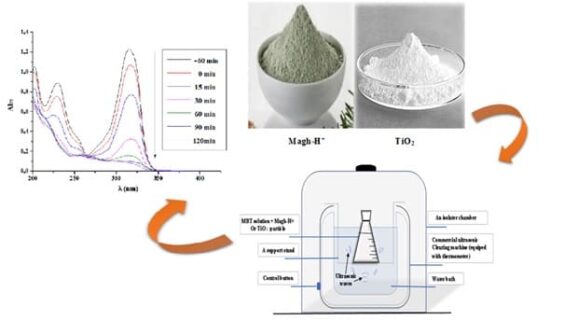Sonocatalytic degradation of 2-Mercaptobenzothiazole (MBT) in aqueous solution by a green catalyst Maghnite-H+
Authors
-
Kawther Nesrine Benkhemkhem
 1
1
-
Sarra Bourahla
*
 1
1
-
Hanane Belayachi
 1
1
-
Fadela Nemchi
 1
1
-
Mostefa Belhakem
 1
1
Abstract
The sonocatalytic activity of the particles of the green Maghnite-H+ sonocatalyst was tested by the degradation of 2-Mercaptobenzothiazole (MBT) under ultrasonic irradiation was performed in an ultrasonic bath with a frequency of 40 kHz, and an ultrasonic power of 120 W for 120 min at room temperature followed by UV-visible analysis. This study was accompanied by the application of a commercial catalyst approved in the literature, TiO2-anatase. The catalysts used were characterized by X-ray diffraction (XRD), Fourier transform infrared spectroscopy (FT-IR), Brunauer–Emmett–Teller (BET), and the band gap energy of Maghnite-H+ was determined by the Tauc method. Different experimental conditions, such as the dose of the catalyst, the initial concentration of MBT, and the addition of H2O2, were studied to determine their effects on sonocatalytic degradation. At a concentration of [MBT] = 10 mg. L-1, the degradation rates of MBT after 120 min of sonocatalysis are 94.29% for Maghnite-H+ and 40.22% for TiO2-anatase. The effect of the concentration of MBT is proportional to the rate of degradation. The addition of H2O2 (0.5 mol. L-1) improved the efficiency of the degradation to 97% for the Maghnite-H+ and 87.85% for the TiO2-anatase. For an initial MBT concentration of 10 mg. L-1, the total organic carbon (TOC) measurement revealed that after 120 minutes, 82.79% and 28.54% mineralization was observed for US/Maghnite-H+ and US/TiO2 systems, respectively.
Highlights
§ Preparation of Maghnite-H+,
§ The Maghnite-H+ and TiO2 used were characterized by X-ray diffraction (XRD), Fourier transform infrared spectroscopy (FT-IR), and the band gap energy of Maghnite-H+ was determined by the Tauc method.
§ Study of the sonocatalytic activity of the green Maghnite-H+ sonocatalyst was tested by the degradation of 2-Mercaptobenzothiazole (MBT) under ultrasonic irradiation was performed in an ultrasonic bath (frequency of 40 kHz, and an ultrasonic power of 120 W) for 120 min at room temperature.
§ This study was accompanied by applying a commercial catalyst approved in the literature, TiO2-anatase.
§ Different experimental conditions such as catalyst dose, initial MBT concentration, and H2O2 addition were investigated to determine their effects on the sonocatalytic degradation of MBT.
§ Study of UV-visible absorption spectra and reaction mechanism.




